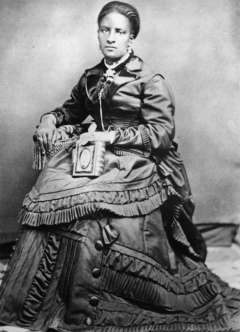- Home
- Encyclopedia
- Could Women of Color Vote In The 1870 Election?
Could Women of Color Vote in the 1870 election?
It appears that there would have been no legal bars to non-white women who were over 21 years old and U.S.citizens voting in Wyoming after the passage of the Women's Suffrage Act of 1869. Whether they exercised that right during the 1870 election is another question.

There were few women in the territory and even fewer women of color, thus anecdotal evidence is scarce, though it does exist. With enough digging into census and voting records, examples may be found to help answer the question of whether women of color were at least registered to vote. Voting then was not done by secret ballot; the Laramie Daily Sentinel, for example, announced the day after the election that 93 women had voted in Laramie, of whom 64 had "voted the Republican ticket." Further, there were no voter rolls at the time, so it would be very difficult to find exactly out who voted in 1870--and of those, how many were women of color.
Six years after the event, Wyoming Territorial Supreme Court Justice John Kingman recalled a group of African-American women voting in the 1870 election in Cheyenne:
I remember a case in point, which, at the time, caused me much uneasiness. We had, at first, a large proportion of Southern men and of Northern Copperheads. By that I mean men who advocated secession, and came to Wyoming to escape being drafted [in the Civil War]. Carriages were employed by the candidates to bring ladies to the polls. At the hotel were a number of colored girls employed as servants. After a while a carriage drove up with four of these colored girls in it. They were helped out, and as they went up to the polls the crowd quietly parted; they voted and returned to the carriage without a word said. Then I breathed freely; I knew that all was safe."
Census figures
In 1870, only 10 black women over the age of 21 were enumerated in the Territory, all of whom would have been eligible to vote. By 1890, that number had grown to 187 total black women, though this most likely included a few Asian and "civilized Native American" women as well.
The numbers for Asian women were even more minuscule. Only five were enumerated in 1870, all Chinese though Japanese was also a classification that year. The 1890 census statistics did not break out gender numbers or ages for non-black colored classifications. These few women were lumped under the "colored" category. Most likely, women reported as "Asian" would not have been eligible to vote as nearly all were foreign born and not naturalized citizens.
With some exceptions, Native American women would not have qualified to vote until 1924, when Congress passed the Indian Citizenship Act.
The Federal census statistics did not include numbers for Hispanic/Latina women until the 1980 census when "Hispanic" became a racial classification option. Prior to 1980, the Hispanic/Latina population was included in the "other non-white" classification. In 1930, the country of birth statistics was included and 44 women were reported to have been born in Mexico. This number, of course, did not include individuals born in the U.S. who were identified as Hispanic or whose parents, grandparents or other ancestors were Hispanic, nor those born in countries other than Mexico.
—Compiled by Wyoming State Archives. Used with thanks.
Resources
- “Census of Population and Housing, 1890.” United States Census Bureau, accessed July 17, 2019 at https://www.census.gov/prod/www/decennial.html.
- Cheyenne Daily Leader, September 6, 1870 p1 c 1.
- Compendium of the 11th Census: 1890 Part III. 1897. United States Department of the Interior, Census Office. Archives.gov, accessed July 17, 2019 at https://www.archives.gov/research/census/1890.
- 1870 Census: Volume 2. The Vital Statistics of the United States. 1872. United State Census Bureau, accessed July 17, 2019 at https://www.census.gov/library/publications/1872/dec/1870b.html.
- Kingman, John W. “Woman Suffrage in Wyoming: Six Years’ Practical Workings, Testimony delivered January 18, 1876, before the Massachusetts Legislature.” Accessed July 18, 2018 at https://drive.google.com/file/d/0Bw8kjiuFbWv8LU14d3lpVy1td2NXckNQOElRZXZhRjQ5U0FR/view.
- Laramie Daily Sentinel, September 7, 19, 1870, p2 c1, p3 c2.
- “1870 Overview.” United States Census Bureau, accessed July 17, 2019 at https://www.census.gov/history/www/through_the_decades/overview/1870.html.
- “1890 Overview.” United States Census Bureau, accessed July 17, 2019 at https://www.census.gov/history/www/through_the_decades/overview/1890.html.
- Publications. United States Census Bureau, accessed July 17, 2019 at https://www.census.gov/library/publications.html.
- Viner, Kim. Email, on lack of secret ballots and voter rolls in 1870 election, to WyoHistory.org, Aug. 3, 2019.
Illustration
- The 1890 photo of Nancy Phillips is from Wyoming State Archives. Staff of the Sweetwater County Museum in Green River tells us that Phillips, a formerly enslaved person, "came to Green River in 1868, possibly as a servant for S.I. Field and his family, and Field later gifted her the house next to the Sweetwater Brewery. She ran a dress shop out of this house and was a midwife, delivering many babies in Green River." Photo is used with permission and thanks to State Archives and to the Sweetwater County museum for the info.
